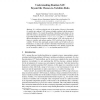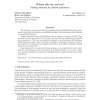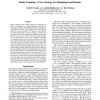11 search results - page 2 / 3 » Using Randomization and Learning to Solve Hard Real-World In... |
CP
2004
Springer
13 years 10 months ago
2004
Springer
It is well known that the ratio of the number of clauses to the number of variables in a random k-SAT instance is highly correlated with the instance’s empirical hardness. We con...
CORR
2011
Springer
12 years 11 months ago
2011
Springer
In this paper, we study the average case complexity of the Unique Games problem. We propose a natural semi-random model, in which a unique game instance is generated in several st...
JAIR
2000
13 years 4 months ago
2000
The local search algorithm WSat is one of the most successful algorithms for solving the satisfiability (SAT) problem. It is notably effective at solving hard Random 3-SAT instanc...
JSAT
2008
13 years 4 months ago
2008
We introduce a new jump strategy for look-ahead based satisfiability (Sat) solvers that aims to boost their performance on satisfiable formulae, while maintaining their behavior o...
AAAI
2006
13 years 6 months ago
2006
Model counting is the classical problem of computing the number of solutions of a given propositional formula. It vastly generalizes the NP-complete problem of propositional satis...



